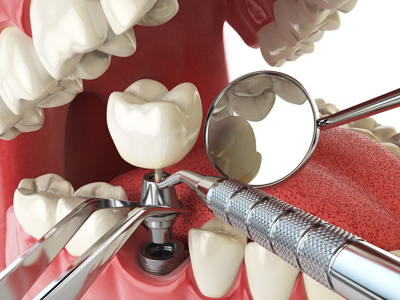
One of the popular dental treatments performed here at Oyster Point Dental is Dental Implant Placement. The process involves several steps and may vary depending on individual conditions. Here's our step-by-step process for dental implant placement:
Initial Consultation: During this consultation, our dentist will evaluate your oral health, review your medical history, and assess whether you are a suitable candidate for dental implants. They may also take X-rays or perform a CT scan to assess the condition of your jawbone and determine the optimal placement of the implants.
Treatment Planning: Based on the initial consultation and diagnostic tests, our dentist will create a personalized treatment plan. This plan outlines the number of implants needed, the type of restoration (such as crowns, bridges, or dentures) that will be attached to the implants, and the timeline for the procedure.
Tooth Extraction (if necessary): If you have a damaged or decayed tooth that needs to be replaced with an implant, the dentist may need to extract the tooth before proceeding with the implant placement. In some cases, tooth extraction and implant placement can be done in the same visit, while in others, a healing period may be required between the two procedures.
Implant Placement: Our dentist will administer local anesthesia to numb the area where the implant will be placed. They will then make an incision in the gum tissue to expose the underlying jawbone. Using specialized drills and tools, they will create a small hole in the bone to precisely position the implant. The implant, which is a titanium screw-like structure, is then inserted into the hole and secured in place. In some cases, a temporary restoration may be placed over the implant during the healing process.
Osseointegration: After the implant is placed, a process called osseointegration takes place. This is when the implant fuses with the surrounding bone, creating a stable foundation for the artificial tooth. It typically takes several weeks to a few months for osseointegration to occur, allowing the implant to become fully integrated with the jawbone.
Abutment Placement: Once osseointegration is complete, a minor surgical procedure may be performed to place an abutment on top of the implant. The abutment is a connector that protrudes through the gum line and serves as the attachment point for the final restoration.
Final Restoration: After the gums have healed and the abutment is in place, impressions of your mouth are taken to fabricate a custom-made dental crown, bridge, or denture. This restoration is designed to match the shape, size, and color of your natural teeth. It is then securely attached to the abutment, completing the dental implant process.
Follow-Up Care: Once the restoration is in place, your dentist will provide instructions on how to care for your dental implants properly. Regular check-ups and professional cleanings are essential to monitor the health of your implants and maintain good oral hygiene.
It's important to note that the dental implant process can vary depending on individual factors, such as the condition of the jawbone and the number of implants needed. Our dentist will provide a detailed treatment plan and guide you through each step of the process based on your specific needs.





